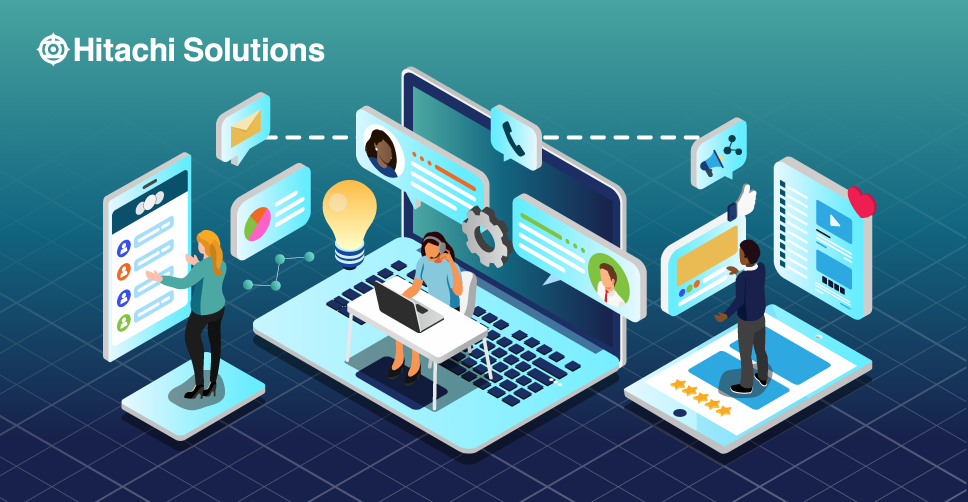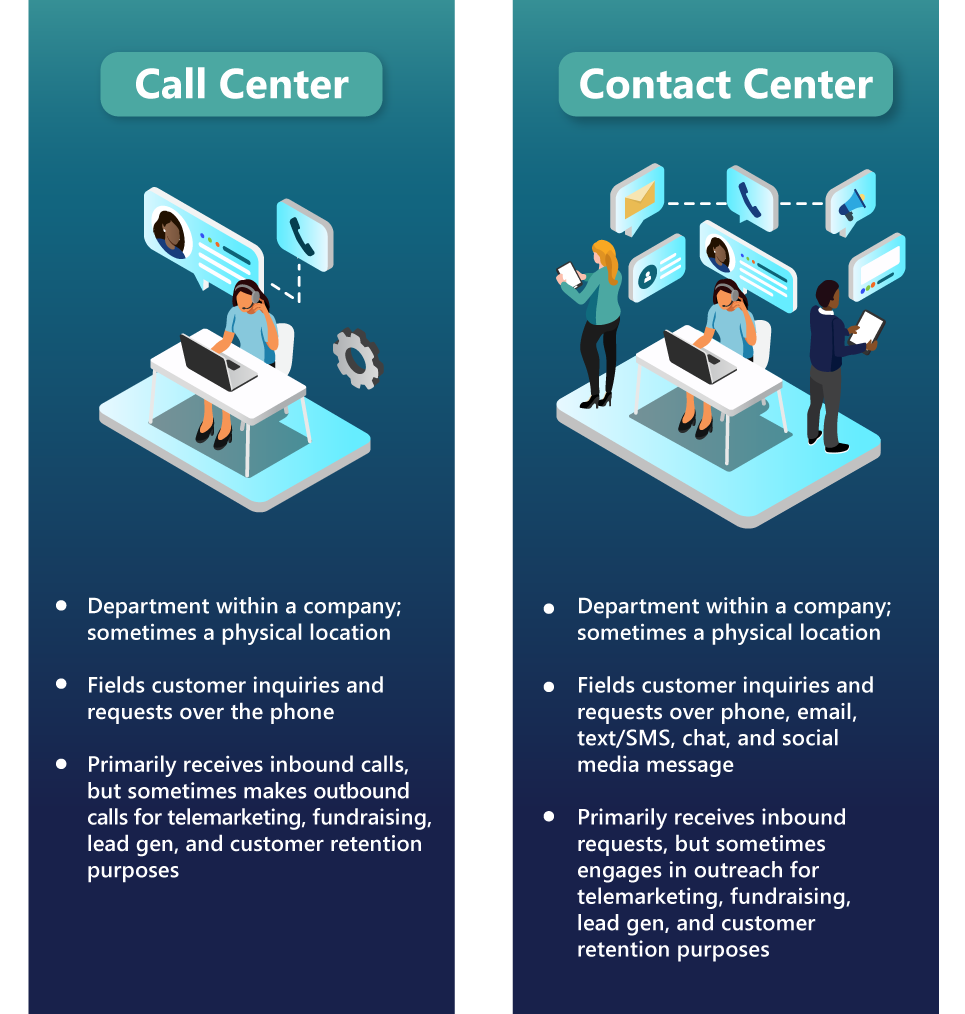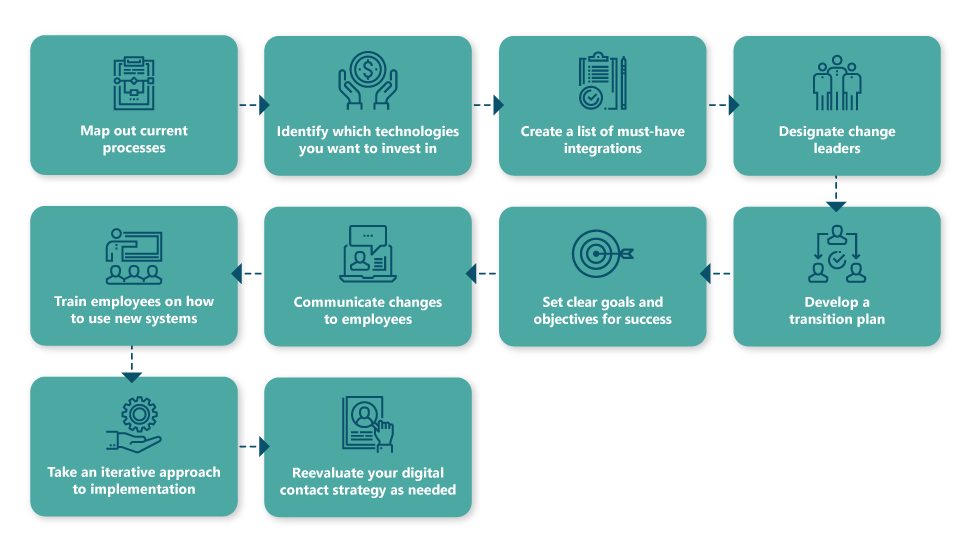

Customer Insights and Azure Synapse
Azure Synapse’s power to analyze and synthesize data, with Dynamics Customer Insights can make your data struggles a pain of the past.
Download the OfferThe call centers of the past have headed the way of the dinosaurs.
In what should come as a surprise to no one, today’s customers increasingly rely on digital channels for everything from shopping to education to keeping in touch with family and friends — and this reliance extends to customer service and support. Given the nature of their on-the-go lifestyles, customers expect businesses to offer them the ability to submit support requests from their mobile device of choice and to talk to customer service representatives (CSRs) over the phone, via email, chat, and more.
To meet these changing expectations and prepare for the future, it’s imperative that businesses transform their call centers — or even their contact centers — into digital contact centers.
The Difference Between Call Centers & Contact Centers
Before we dig into contact center digital transformation, let’s first clarify the distinction between call centers and contact centers.
At a high-level, a call center refers to a department within a company or organization responsible for fielding customer inquiries and requests over the phone. In some instances, a call center may even refer to a specific location. Although it’s more common for call centers to field inbound calls, some make outbound calls for telemarketing, fundraising, lead generation, and customer retention purposes.
Conceptually, contact centers are very similar to call centers, the key difference being that contact centers span a wider variety of communication channels, including voice calls, text/SMS messages, chat, social media messages, and email, thereby presenting customers with more options. Similar to call centers, some contact centers do engage in outreach.

What Is a Digital Contact Center?
Although you might assume that contact centers are digital by default, given the number of digital channels they encompass, that isn’t entirely true. What distinguishes a digital contact center from a contact center is the tools and technologies it uses.
For example, a CSR at a contact center might use chat functionality to communicate with a customer visiting their company’s website. By comparison, a digital contact center might use an artificially intelligent chatbot to field low-level requests — that is, anything that could be resolved by answering a few simple questions — and escalate more complex inquiries to a live agent.
That same digital contact center might utilize intelligent routing to identify the agent best suited to address the issue and then employ omnichannel orchestration and automation to connect the customer with that agent, seamlessly moving from one channel to another in the process.
Digital contact centers are advanced not only because of how they handle customer service and support, but also because of the data they collect and what they’re able to do with that data.
Every customer service interaction presents an opportunity for businesses to learn about who their customers are, what matters to them, what issues they commonly experience, and how best to resolve those issues. By recording those interactions — with customers’ consent, of course — and then applying analytics and machine learning techniques such as natural language processing (NLP) to them, digital contact center managers can access valuable insights that inform future decisions. They can then leverage these insights for training purposes and to enhance efficiency, thereby improving first-call resolution (FCR) and increasing customer satisfaction.
Key Components of a Digital Contact Center
A digital contact center should utilize the following technologies:
- Automation: Automation is one of most fundamental digital contact center technologies and plays a vital role in everything from intelligent routing and real-time agent assistance to data collection and volume forecasting. CSRs can use business process automation (BPA) to streamline workflows for after-contact work, such as data entry and scheduling follow-up actions. Businesses can even combine automation with artificial intelligence (AI) for robotic process automation (RPA).
Ultimately, automation enables agents to be more productive and digital contact centers to be more efficient, which has the potential to reduce costs, improve customer satisfaction, and enhance overall performance. - Artificial Intelligence: Similar to automation, the applications for AI in customer service are far ranging, and include predictive routing, chatbots, sentiment analysis, intent recognition, RPA, and much more.
- Machine Learning: A subset of AI, machine learning can be used to develop algorithms or construct models. Businesses can feed digital contact center data into these algorithms and models and use them to identify common patterns and behaviors, draw correlations, and make improvements. For example, a digital contact center manager may, through using machine learning, recognize that customers respond best when live agents use a particular tone of voice or turn of phrase. They could then build that information into future modules.
Perhaps the most exciting thing about machine learning algorithms and models is that they — as their name implies — learn and evolve over time. By aggregating and feeding more data into algorithms and models, they become more sophisticated and generate more accurate insights. - Cloud Computing: Compared to traditional contact centers, which rely on legacy systems and on-premise infrastructure — which can be expensive to implement, maintain, and scale over time — the contact center of the future is entirely cloud-based. Cloud technology makes it easy for digital contact centers to add new channels as they emerge and to scale headcount up or down as needed depending on seasonal demand.
Cloud computing also has the potential to open doors for contact centers in terms of hiring. According to a survey from McKinsey, 87% of respondents said that they would take their employers up on the opportunity to work flexibly. With cloud-based systems, digital contact center managers can support their agents regardless of their location, creating remote work opportunities and giving businesses the upper hand in a competitive job market. - Data Analytics: It’s no secret that contact centers collect large quantities of data on a daily basis, but without a way to parse that data — both structured and unstructured — and extract actionable insights, it doesn’t have much value.
Fortunately, advanced analytics — a staple in digital contact centers — empowers business leaders and contact center managers to make sense of that data and tap into its hidden potential. Armed with the insights that only data analytics can reveal, contact centers can develop standardized processes that improve performance metrics, reduce call volumes by identifying (and addressing) common issues, assess the potential impact of unexpected downtime, and much more. - Self-service Portals: When it comes to simple requests or inquiries, few customers want to waste time waiting to be connected to a live agent. On the other end of the equation, few agents want to dedicate their time and energy to answering the same basic questions hundreds of times a day. Self-service portals are the perfect compromise, empowering customers to seek answers to their own questions using company resources — typically a centralized knowledge base — and freeing agents up to focus on more challenging and rewarding tasks.
Digital contact centers can even use self-service portals to reduce contact queues by giving customers the opportunity to submit support tickets themselves, rather than rely on a CSR. This also enables agents to see an updated list of support requests in real time and prioritize them based on the nature of the request and its urgency, allowing for a more efficient flow of work. - Interactive Voice Response and Intelligent Routing: Powered by automation and artificial intelligence, interactive voice response (IVR) is an automated calling system that prompts customers to answer a series of question or select options from a voice-activated menu. Based on their responses and selections, customers are then routed to the appropriate agent.
Although IVR on its own has been commonplace in call centers for some time, it’s the intelligent routing component that makes it truly advanced. Using rules-based engines, AI, and automation, intelligent routing analyzes customer inquiries captured through IVR, determines which agent would be most qualified to handle the call based on their skill level and availability, and automatically connects the customer with that agent. For this reason, intelligent routing is also sometimes known as skills-based routing.
Although intelligent routing got its start in call centers, as the technology that underpins it has become more mature and sophisticated, it’s since been expanded to other digital channels, including text messages and social media, making it essential for digital contact centers. - Biometric Authentication: Certain customer service interactions may require customers to share sensitive or otherwise private information with agents, such as their personal phone number, home address, email address, credit card credentials, or social security number. In order to prevent unauthorized individuals from accessing this information for potentially malicious purposes, it’s imperative that companies invest in advanced security measures, including biometric authentication. Although knowledge-based authentication — a method of identity verification that relies on customers entering a password or PIN or answering a security question — has long been the standard for contact centers, fraudsters can purchase authentication information on the dark web. Even under the best circumstances, customers can forget their authentication details or get frustrated with having to repeatedly verify their identity.
Biometrics eliminates these risks and frustrations by using AI to verify a customer’s identity based on who they are — that is, what their voice sounds like, how they behave, and even how they speak. Biometric authentication is the next frontier of digital contact center security and is a must-have technology for any contact center of the future.
If there’s one key takeaway here, it’s that all of the technologies listed above are closely related and rely on each other to optimally function. Bearing that in mind, it’s essential that any organization hoping to develop a contact center of the future invest in advanced systems that can seamlessly integrate and communicate with one another.
7 Reasons Why Digital Contact Centers Are the Contact Centers of the Future
Since we’ve already covered quite a few of the benefits to digitally transforming your contact center, let’s do a quick review. By investing in digital contact center technology, you’ll enjoy:
- Increased agent productivity because automation will save staff from performing tedious, time-consuming tasks, enabling them to dedicate their focus to responding to customers; analytics-based insights will enhance agent training; and artificially intelligent virtual assistants will provide them with coaching and personalized recommendations in real time.
- Greater overall efficiency because BPA and RPA will enable you to automate business-critical workflows and machine learning algorithms, and models will provide the insights you require to identify areas in need of improvement and optimize operations.
- Reduced operating costs because chatbot technology and self-service portals will enable your customers to resolve low-level inquiries on their own and you to dedicate your most valuable resources — your CSRs — to higher priority and more complex requests.
- Greater scalability because analytics-based forecasting will provide you with visibility into future demand, and cloud computing will make it easy to add headcount to existing systems during the holidays and peak seasons.
- Stronger security because biometric authentication — powered by AI — prevents fraudsters and otherwise unauthorized individuals from accessing confidential customer information, while still enabling customers to easily verify their identities.
- Optimized customer experience because with chatbot technology and self-service portals, customers will never have to wait for service; with intelligent routing, they can rest assured that they’ll always be connected to the agent most qualified to resolve their problem or answer their question; and with omnichannel orchestration, they’ll be able to seamlessly move from one contact channel to another without having to restate their issue.
- Improved customer satisfaction because agents are more likely to be engaged and customers’ issues are more likely to be resolved on first contact.
The Journey to Contact Center Digital Transformation

At a high level, the journey toward modernizing your contact center and transforming it into a contact center of the future should look something like this:
- Map out current processes. Determine which processes have the potential to be optimized using digital contact center technology, and which ones can be automated entirely.
- Identify which technologies you want to invest in. Automation, AI, and analytics should be the bare minimum. Once you have a clear understanding of those three technologies and their role within your contact center, you can begin to assess additional tools and capabilities.
- Create a list of must-have integrations. Make sure your company’s customer relationship management and customer data platforms are at the top of the list. By defining these integrations early on, you can ensure that all of your systems are set up properly and that your agents have access to a single (and accurate) source of truth.
- Designate change leaders. When undergoing contact center digital transformation, it’s important to have a team of reliable individuals who are respected by both their peers and their managers to lead the way. These change leaders will help other employees get up to speed on new technology while building trust and securing their buy-in along the way.
- Develop a transition plan. Other than investing in and implementing the necessary tools and technologies, determine what else do you need to do to take your contact center from its current state to its ideal state. Use this as a framework to create a checklist of actionable tasks — each with a specific timeline — and determine who within your organization would be most qualified to address each item on that list.
- Set clear goals and objectives for success. It’s one thing to develop a transition plan for your contact center digital transformation, another entirely to gauge whether it’s successful. Bearing that in mind, you’ll want to set clear, quantifiable goals — for example, “Achieve an FCR of 75% by next quarter” — to determine the efficacy of your plan.
- Communicate changes to employees. Your newly minted change leaders will be integral to this, helping agents understand the need for digital contact center transformation and what they can do to be successful moving forward.
- Train employees on how to use new systems. Advanced tools and technologies such as data analytics and machine learning can be game-changing for contact centers, but only if agents and managers understand how to use them. Your digital contact center training curriculum should be thorough; all training documents should live within an easily accessible, centralized location; and you should conduct additional training on an as-needed basis to keep employees’ skills fresh.
- Take an iterative approach to implementation. Rather than aim for overnight contact center digital transformation, start by making smaller changes to your infrastructure and your processes and grow your investment over time. This will provide you with a clearer view of what works and what doesn’t, so you can make more informed decisions and make continuous improvement part of your digital contact center strategy.
- Reevaluate your digital contact center strategy as needed. Once again, in the spirit of continuous improvement, it’s imperative that you routinely reevaluate the systems and approaches you’ve implemented in your digital contact center to ensure that you’re utilizing them as effectively as possible and that they continue to meet your organization’s needs.
Discover the 7 Key Principles for Implementing Meaningful Digital Change >>
Create Your Own Digital Contact Center Strategy
There’s no time like the present to transform your contact center into a contact center of the future — and Hitachi Solutions is here to help you get started. Using Microsoft’s all-new Digital Contact Center Platform, which combines the best of Nuance AI, Teams, Dynamics 365, Azure, and the Power Platform, and leveraging our decades of technological expertise and customer service experience, we can help you take the first step toward contact center digital transformation.
Contact the experts at Hitachi Solutions to learn more.


